iPhone 5S vs iPhone 5
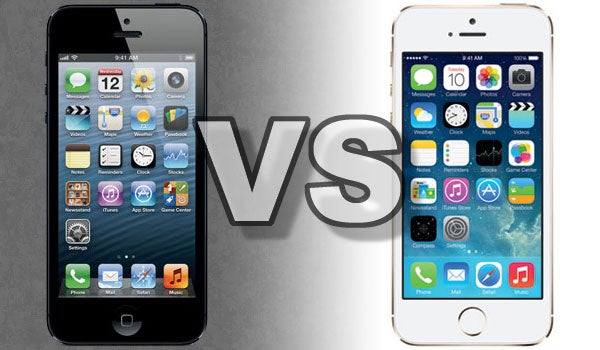
The iPhone 5S is the first 64-bit phone. It’s faster, and has a better camera than the iPhone 5 and offers features that are simply missing from the older phone.
But is it worth the upgrade? We’ve compared the iPhone 5S and iPhone 5 to see if this is an essential upgrade, or one you can skip.
iPhone 5S vs iPhone 5 – Release Date
iPhone 5S – September 2013
iPhone 5 – September 2012
Like all of Apple’s key mobile series, the iPhone range is updated yearly. The iPhone 5 was the 2012 edition, and the iPhone 5S is the new model for 2013. It’ll be the ‘current’ model for most of 2014 too, though.
The iPhone 5 launched in September 2012 – in time for those who were after a particularly pricey Christmas present. Like clockwork, the iPhone 5S arrived in September 2013.
It’s highly unlikely the iPhone 6 will arrive until around the same time in 2014, if you’re worried about your iPhone 5S getting old before its time.
iPhone 5S vs iPhone 5 – Deals
![]()
iPhone 5S – £549 SIM-free from Apple, from £42 a month
iPhone 5 – No longer available from Apple, from £32 a month
The iPhone 5S launch saw Apple discontinue the iPhone 5. You can no longer buy that phone from the online Apple Store – the iPhone 5C is intended to offer a slightly lower-cost alternative to the ‘legacy’ iPhone 5 these days.
However, there are naturally still loads of iPhone 5 phones about, so you can still snap one up from a mobile network. They generally cost around the same amount as an iPhone 5C – about £32 a month on contract, without any additional up-front cost. The iPhone 5 is not a cheap phone, despite being a discontinued model.
The iPhone 5S is one of the priciest phones available. It starts at £549 from Apple – that gets you the 16GB version – and contracts without any extra up-front cost tend to cost around £42 a month.
Over the course of a two-year contract, opting for an iPhone 5 rather than an iPhone 5S will save you around £240.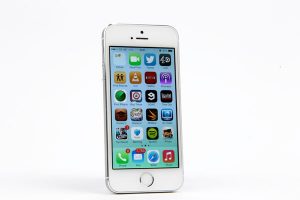
iPhone 5S vs iPhone 5 – Design
![]()
iPhone 5S – 7.6mm thick, 112g, aluminium rear, toughened glass front
iPhone 5 – 7.6mm thick, 112g, aluminium rear, toughened glass front
The designs of the iPhone 5S and iPhone 5 are almost identical. Beautiful industrial design and superb build quality is matched with a phone that feels almost impossibly thin and light if you’re upgrading from an older, chunkier phone.
They are just 7.6mm thick, and weigh 112g. That’s thinner and lighter than all of the big-name Android rivals.
Most of the rear of the phone is made of lightly textured aluminium, and there are black/white glass cut-outs on the top and bottom at that help to avoid the sort of signal issues you can get with all-metal gadgets.
One of the best hardware elements of an iPhone is that the phones are so easy to use. We’re not talking about the software here, but the hardware – where many Android phones are a bit too large to use comfortably in one hand, the iPhone 5S and iPhone 5 fit in even small hands perfectly.
Both phones use the standard Apple Lightning port, which made its debut with the iPhone 5 in 2012. These phones won’t work with the 30-pin Apple cables of former Apple phones, but Apple does produce a 30-pin to Lightning adapter if you’ve already forked out for a fancy speaker dock for an older model of iPhone.
There’s just one significant visual difference in the construction of the iPhone 5S and iPhone 5. The Home button of the 5S is outlined by a metallic ring – it’s part of the Touch ID sensor fingerprint scanner, which you don’t get on an iPhone 5. More on that later. 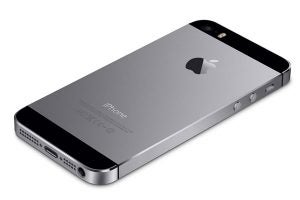
iPhone 5S vs iPhone 5 – Colours
![]()
iPhone 5S – space grey, white/silver, gold
iPhone 5 – black/slate, white/silver
Apple introduced colourful iPhones in 2013 with the iPhone 5C, but the iPhone 5S colours remain fairly conservative. There’s just one new one – a ‘champagne’ style gold. However, the gold edition has suffered from stock issues, making it the trickiest to get hold of.
The white and black colours of the iPhone 5 are also available with the iPhone 5S, but the darker iPhone has been lightened a bit.
The darker iPhone 5 was called the ‘black/slate’ model, where the iPhone 5S alternative is called ‘space grey’. Forgetting Apple’s naming for a minute, the iPhone 5S version is lighter.
We think it’s a moderate improvement visually, and it wears better too. The aluminium backs of the iPhone 5S and iPhone 5 are prone to scratching, and as scratches show the shiny aluminium underneath, they’re much less apparent with the new, lighter ‘space grey’ finish.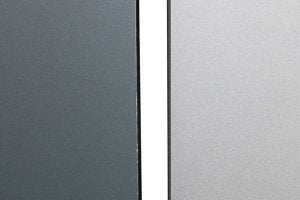
Slate vs Space grey – the two finishes compared
iPhone 5S vs iPhone 5 – Touch ID Sensor
![]()
iPhone 5S – Touch ID sensor
iPhone 5 – No Touch ID sensor
The most obvious new hardware feature of the iPhone 5S is its Touch ID sensor. This is the fingerprint scanner that sits under the surface of the Home button.
What it lets you do is restrict who can unlock your phone without having to resort to a passcode. All you do is to place your finger of choice on the Home button, wait a fraction of a second and the phone does the rest. You need to ‘teach’ the iPhone 5S what your finger looks like first of all, but it’s a quick and painless process.
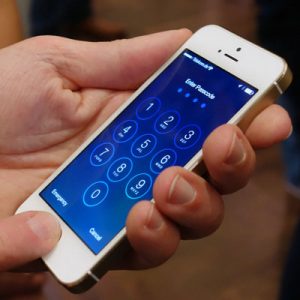 The fingerprint scanner can also be used to stop you having to input your password when buying new apps from iTunes – although you can disable this feature if it seems like a way to accidentally spend money.
The fingerprint scanner can also be used to stop you having to input your password when buying new apps from iTunes – although you can disable this feature if it seems like a way to accidentally spend money.
Having thought the Touch ID sensor might be a gimmick, we find it an excellent time-saver in actual use.
Want to know more about how it works? It doesn’t, as you might assume, simply take a photo of your fingerprint, but performs a capacitive scan.
The conductive properties of your finger alter depending on the valleys and ridges of your fingerprint, though, so in reality the effect is the same. But it means you can’t simply unlock an iPhone 5S with a high-resolution print-out of someone’s finger or thumb.
iPhone 5S vs iPhone 5 – Screen
![]()
iPhone 5S – 4-inch IPS 1,136 x 640 pixel screen
iPhone 5 – 4-inch IPS 1,136 x 640 pixel screen
The screens of the iPhone 5S and iPhone 5 are almost identical. They are both 4-inch displays with 1,136 x 640 pixel IPS panels, offering 326ppi pixel density. That’s the same level of sharpness seen in the iPhone 4 and iPhone 4S, but it’s high enough to make text appear super-sharp. As Apple likes to boast – you can’t see the pixels.
Actual image quality is excellent in both phones. Colours are rich and fairly accurate, contrast is great and black depth is excellent for an LCD-type screen. As usual with an Apple mobile device, viewing angles are just about perfect too.
Apple is rumoured to be planning a larger-screen phone for next year, but these phones’ screens are exactly the same size. And while they are bigger than those of early iPhones, they don’t feel that much bigger as the screen has only gotten taller (or longer, if you like). The screen width is the same as the very first iPhone, from back in 2007.
iPhone 5S vs iPhone 5 – Software
![]()
iPhone 5S – iOS 7
iPhone 5 – iOS 7
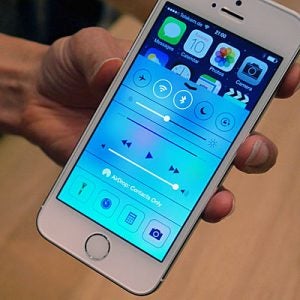 The iPhone 5S and iPhone 5 use exactly the same software – iOS 7. There are improvements made in the iPhone 5S’s hardware, but they don’t fundamentally alter what the phone feels like to use.
The iPhone 5S and iPhone 5 use exactly the same software – iOS 7. There are improvements made in the iPhone 5S’s hardware, but they don’t fundamentally alter what the phone feels like to use.
If you’re a current iPhone user, it’s likely you’ve already made the leap to iOS 7. But if you’re new to the system, it’s slick, good-looking and easy to use.
iOS 7 was the biggest update to the system since its birth back in 2007. It made the OS look and feel more modern, with a new design and better-looking screen transitions. It also added several features seen in smartphone rival Android – giving you easier control over things like screen brightness, Wi-Fi and so on.
System software isn’t a reason to pick the iPhone 5S over the iPhone 5, though.
iPhone 5S vs iPhone 5 – CPU, GPU and RAM
![]()
iPhone 5S – 64-bit dual-core 1.3GHz Apple A7, 1GB RAM, PowerVR G6430 GPU
iPhone 5 – 32-bit dual-core 1.3GHz Apple A6, 1GB RAM, PowerVR SGX 543MP3 GPU
If we were to talk in the terms we usually use when describing phone processors, the iPhone 5S doesn’t sound like much of a power upgrade over the iPhone 5 – both have dual-core 1.3GHz processors made by Apple, both have 1GB of RAM. In truth, the iPhone 5S is much, much more powerful than the previous model.
It’s the first 64-bit phone processor we’ve ever used, and it’s also much faster than rival quad-core Android phone CPUs despite being ‘just’ dual-core.
To see the real benefits of this extra power you’ll need to wait a bit. The iPhone 5 is already capable of excellent visuals in games, and it has enough power to make iOS 7 run quickly. Without an increase in screen resolution, there’s not an obvious avenue for the extra power to be routed down.
Apple does claim that the extra power is part of the reason why the fingerprint scanner is able to work so quickly – the 64-bit CPU allows for fast processing of the data involved. However, in most respects it’s not a particularly obvious change.
It’s not just the GPU that has been upgraded, though. The 1GB of RAM has gotten faster – moving from DDR2 to DDR3-type RAM – and the GPU is more advanced too.
The iPhone 5 uses a triple-core PowerVR SGX 543MP3, the iPhone 5S a quad-core PowerVR G6430. It’s about 2.5 times faster than the older phone’s chip.
There’s masses of potential in the iPhone 5S – it just won’t be realised fully for a little while.
iPhone 5S vs iPhone 5 – Apps and Games
![]()
iPhone 5S – App Store – minor 64-bit optimisations
iPhone 5 – App Store
There are some apps that already offer optimisation for the iPhone 5S and its 64-bit cohorts the iPad Air and iPad mini 2, though.
Our favourite demo of the difference is Apple’s Garageband music-making software, which offers 32 tracks for any 64-bit mobile devices including the iPhone 5S. You only get 16 tracks with an iPhone 5. It’s a pretty clear demonstration that with a 64-bit processor Apple is starting to offer capabilities that might be compared with those of a desktop PC.
Other apps that offer Apple A7 CPU optimisation include –
djay 2
What is it? A virtual DJ app
You can simultaneously process two 720p video streams at once with an iPhone 5S, and perform real-time transposing of songs.
Sketchbook mobile
What is it? An art/drawing app
With a 64-bit phone, you can use larger canvases and larger brushes in this art app. That may not seem like a big change, but here it is the biggest change – the level of processing that goes into ‘natural brush’ apps like this is intensive.
Galaxy on Fire 2 HD
What is it? A 3D space shooter
Veteran 3D mobile game developer Fishlabs was among the first companies to get to grips with the Apple A7 processor. It added extra lighting effects to its excellent space shooter Galaxy on Fire 2 HD for iPhone 5Ss.
iPhone 5S vs iPhone 5 – Camera
![]()
iPhone 5S – 8-megapixel camera, 1/3.2-inch sensor, dual-LED ‘true tone’ flash
iPhone 5 – 8-megapixel camera, 1/3-inch sensor, LED flash
Contrary to what many expected, Apple didn’t make massive conspicuous changes to the iPhone 5S’s camera. There are improvements, but they are fairly subtle ones.
Both phone use 8-megapixel sensors, but the iPhone 5S’s is slightly larger. It has a 1/3-inch sensor where the iPhone 5 has a 1/3.2-inch sensor. It’s not a massive difference, but does result in slightly larger sensor pixels – 1.4 microns to 1.5 microns.
The aperture has also been improved, from f/2.4 to f/2.2. This means the lens is ‘faster’, improving low-light performance.
In direct comparisons, it is clear that the iPhone 5S is better than its predecessor.


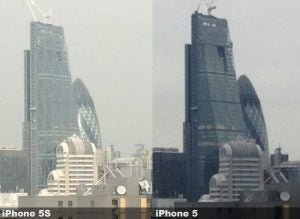
Differences in exposure aside, the iPhone 5S photo is significantly less noisy than the iPhone 5’s. Images are cleaner and clearer, and detail reproduction in much better even though the sensor doesn’t have more pixels to call upon.
Apple has done a sterling job here.
The iPhone 5S also has a new flash. It uses a ‘true tone’ dual-LED flash, rather than the standard single-LED flash used by the iPhone 5.
It differs from a standard dual-LED flash in that its LEDs have differing tones. There’s a ‘warm’ one and a ‘cool’, bright one. The intensity of each LED required at each exposure is judged by the phone, in an attempt to bring more natural-looking results – avoiding blowing out people’s faces, as standard flashes tend to.
The iPhone 5S can also shoot slow-motion 120fps video, which the iPhone 5 cannot do. It’s great fun, but it has been claimed that the video is only recorded at 480p quality, and then upscaled to 720, rather than offering actual HD slo-mo, like the Galaxy Note 3.
The iPhone 5S isn’t going to challenge the Nokia Lumia 1020 in the sheer quality of the photos it can produce, but it is an eminently usable camera. It’s a solid upgrade to the iPhone 5, although not enough reason to upgrade by itself, in our view.
Verdict
The iPhone 5S is a low-key phone upgrade on first impression, but it actually makes some adventurous, intelligent changes. The 64-bit processor, the Touch ID sensor and the new camera flash are by no means ‘standard’ phone upgrades, but ones that try to alter or improve what the phone is actually like to use.
It’s not a phone that makes the iPhone 5 seem out of date, but the iPhone 5S is a true next-generation phone. However, if anything it’s ahead of its time in some respects, and it’ll be a while before we appreciate quite how good it really is.
Next, read our iPhone 5S vs Galaxy S4 comparison


